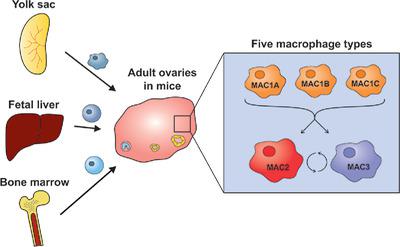当前位置:
X-MOL 学术
›
Eur. J. Immunol.
›
论文详情
Our official English website, www.x-mol.net, welcomes your
feedback! (Note: you will need to create a separate account there.)
Fetal-derived macrophages persist and sequentially maturate in ovaries after birth in mice.
European Journal of Immunology ( IF 4.5 ) Pub Date : 2020-05-27 , DOI: 10.1002/eji.202048531 Heli Jokela 1, 2 , Emmi Lokka 1, 2, 3 , Miikka Kiviranta 1 , Sofia Tyystjärvi 1 , Heidi Gerke 1, 2 , Kati Elima 1, 3 , Marko Salmi 1, 3 , Pia Rantakari 1, 2
European Journal of Immunology ( IF 4.5 ) Pub Date : 2020-05-27 , DOI: 10.1002/eji.202048531 Heli Jokela 1, 2 , Emmi Lokka 1, 2, 3 , Miikka Kiviranta 1 , Sofia Tyystjärvi 1 , Heidi Gerke 1, 2 , Kati Elima 1, 3 , Marko Salmi 1, 3 , Pia Rantakari 1, 2
Affiliation

|
Macrophages, which are highly diverse in different tissues, play a complex and vital role in tissue development, homeostasis, and inflammation. The origin and heterogeneity of tissue‐resident monocytes and macrophages in ovaries remains unknown. Here we identify three tissue‐resident monocyte populations and five macrophage populations in the adult ovaries using high‐dimensional single cell mass cytometry. Ontogenic analyses using cell fate mapping models and cell depletion experiments revealed the infiltration of ovaries by both yolk sac and fetal liver‐derived macrophages already during the embryonic development. Moreover, we found that both embryonic and bone marrow‐derived macrophages contribute to the distinct ovarian macrophage subpopulations in the adults. These assays also showed that fetal‐derived MHC II‐negative macrophages differentiate postnatally in the maturing ovary to MHC II‐positive cells. Our analyses further unraveled that the developmentally distinct macrophage types share overlapping distribution and scavenging function in the ovaries under homeostatic conditions. In conclusion, we report here the first comprehensive analyses of ovarian monocytes and macrophages. In addition, we show that the mechanisms controlling monocyte immigration, the phenotype of different pools of interstitial macrophages, and the interconversion capacity of fetal‐derived macrophages in ovaries are remarkably different from those seen in other tissue niches.
中文翻译:

胎儿来源的巨噬细胞在小鼠出生后的卵巢中持续存在并逐渐成熟。
在不同组织中高度多样化的巨噬细胞在组织发育,体内稳态和炎症中起着复杂而至关重要的作用。卵巢中组织驻留单核细胞和巨噬细胞的起源和异质性仍然未知。在这里,我们使用高维单细胞大规模细胞仪鉴定了成年卵巢中的三个组织驻留单核细胞群和五个巨噬细胞群。使用细胞命运定位模型和细胞耗竭实验进行的致癌分析表明,卵黄囊和胎儿肝来源的巨噬细胞已经在胚胎发育过程中渗透了卵巢。此外,我们发现胚胎和骨髓来源的巨噬细胞均对成年人的卵巢巨噬细胞亚群有所贡献。这些测定还表明,胎儿来源的MHC II阴性巨噬细胞在出生后的卵巢中会分化为MHC II阳性细胞。我们的分析进一步揭示,在稳态条件下,卵巢中发育不同的巨噬细胞类型在卵巢中具有重叠的分布和清除功能。总之,我们在这里报告了卵巢单核细胞和巨噬细胞的首次综合分析。此外,我们发现控制单核细胞迁移的机制,间质巨噬细胞的不同库的表型以及胎儿来源的巨噬细胞在卵巢中的相互转化能力与其他组织小生境明显不同。我们的分析进一步揭示,在稳态条件下,卵巢中发育不同的巨噬细胞类型在卵巢中具有重叠的分布和清除功能。总之,我们在这里报告了卵巢单核细胞和巨噬细胞的首次综合分析。此外,我们发现控制单核细胞迁移的机制,间质巨噬细胞的不同库的表型以及胎儿来源的巨噬细胞在卵巢中的相互转化能力与其他组织小生境明显不同。我们的分析进一步揭示,在稳态条件下,卵巢中发育不同的巨噬细胞类型在卵巢中具有重叠的分布和清除功能。总之,我们在这里报告了卵巢单核细胞和巨噬细胞的首次综合分析。此外,我们发现控制单核细胞迁移的机制,间质巨噬细胞不同库的表型以及胎儿来源的巨噬细胞在卵巢中的相互转化能力与其他组织小生境明显不同。
更新日期:2020-05-27
中文翻译:

胎儿来源的巨噬细胞在小鼠出生后的卵巢中持续存在并逐渐成熟。
在不同组织中高度多样化的巨噬细胞在组织发育,体内稳态和炎症中起着复杂而至关重要的作用。卵巢中组织驻留单核细胞和巨噬细胞的起源和异质性仍然未知。在这里,我们使用高维单细胞大规模细胞仪鉴定了成年卵巢中的三个组织驻留单核细胞群和五个巨噬细胞群。使用细胞命运定位模型和细胞耗竭实验进行的致癌分析表明,卵黄囊和胎儿肝来源的巨噬细胞已经在胚胎发育过程中渗透了卵巢。此外,我们发现胚胎和骨髓来源的巨噬细胞均对成年人的卵巢巨噬细胞亚群有所贡献。这些测定还表明,胎儿来源的MHC II阴性巨噬细胞在出生后的卵巢中会分化为MHC II阳性细胞。我们的分析进一步揭示,在稳态条件下,卵巢中发育不同的巨噬细胞类型在卵巢中具有重叠的分布和清除功能。总之,我们在这里报告了卵巢单核细胞和巨噬细胞的首次综合分析。此外,我们发现控制单核细胞迁移的机制,间质巨噬细胞的不同库的表型以及胎儿来源的巨噬细胞在卵巢中的相互转化能力与其他组织小生境明显不同。我们的分析进一步揭示,在稳态条件下,卵巢中发育不同的巨噬细胞类型在卵巢中具有重叠的分布和清除功能。总之,我们在这里报告了卵巢单核细胞和巨噬细胞的首次综合分析。此外,我们发现控制单核细胞迁移的机制,间质巨噬细胞的不同库的表型以及胎儿来源的巨噬细胞在卵巢中的相互转化能力与其他组织小生境明显不同。我们的分析进一步揭示,在稳态条件下,卵巢中发育不同的巨噬细胞类型在卵巢中具有重叠的分布和清除功能。总之,我们在这里报告了卵巢单核细胞和巨噬细胞的首次综合分析。此外,我们发现控制单核细胞迁移的机制,间质巨噬细胞不同库的表型以及胎儿来源的巨噬细胞在卵巢中的相互转化能力与其他组织小生境明显不同。











































 京公网安备 11010802027423号
京公网安备 11010802027423号